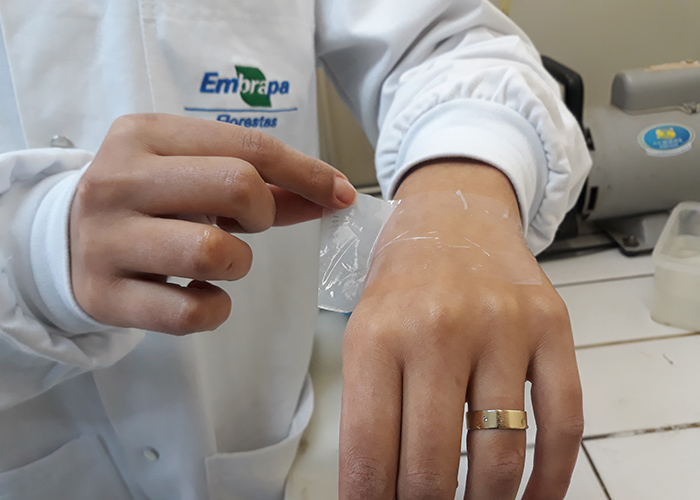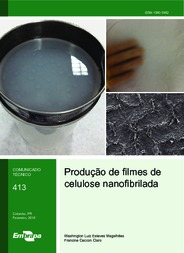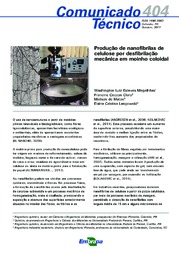Plant nanocellulose is used to treat burns
Plant nanocellulose is used to treat burns
Paper and cellulose industry's most volumous product can also be a solution for Medicine. Bleached cellulose, the world's most abundant natural polymer, can be used in the treatment of burns. A study conducted by the researcher Washington Luiz Esteves Magalhães, from Embrapa Forests, and by Francine Ceccon Claro, a student in the master's degree course in Engineering and Materials Science at Universidade Federal do Paraná (UFPR), used nanotechnology to potencialize physical and chemical properties that add greater value to cellulose in order to develop a membrane to be used in the recovery of burned skin.
The results have shown that because it does not have porosity, the membrane is suitable for applications as a barrier. “The characteristic translucency favors monitoring healing without the need to remove the dressing to assess the wound”, Claro asserts. Another advantage is the production cost, which could be up to a thousand times lower than the dressings available in the market. The technology is going to be subjected to clinical trials and should be available to the public in four years. The research data are available in Francine Claro's dissertation.
Despite the use of bacterial cellulose membranes as artificial skin having been common since the 1980s, this type of manufacture is a low-yield and high-cost process. That is why the group sought a product that would be economically viable as well as efficient.
“The goal of the work was to develop nanofibril membranes made of plant cellulose added with cicatrizing and bactericidal agents such as calendula and silver nanoparticles”, the researcher explains. The research used Pinus as a source of cellulose.
Throughout the years, a large variety of substances has been used as protective agent in burn injuries. The basic principle of a dressing for burns is not to harm the skin, providing a suitable environment to recompose the tissue: sterile, moist and protected from the external environment.
The tests with nanocellulose have revealed that the material has the potential to be used as dressings as it offers cicatrization results that are similar to the ones commercially available without signs of rejection. “The plant cellulose membrane is easily handled and applied, and it features durability and good adherence to the wounded skin”, Washington Magalhães affirms.
Membrane reduced healing time
In tests conducted by veterinarians from the Pontifícia Universidade Católica do Paraná (PUC-PR) and postgraduate researchers from Faculdade Evangélica do Paraná (Fepar) on skin wounds located on the back of rats, the plant cellulose membrane sped up the process of healing in the first four days after application when compared with commercial dressings.
The positive results in laboratory had the project be one of those selected by the Call for Projects on Innovation in the Industry, by the National Industrial Learning Service (Senai), which funds work that intend to place innovative products in the market. The proposal was presented in partnership with Senai's Institute of Biosynthetic Innovation, in Rio de Janeiro, and the startup Zynux.
The goal is to produce the films on a bigger scale. This new stage should take two years. “Later, we will conduct clinical trials with the help of postgraduate students from Faculdade Evangélica do Paraná in Curitiba, a course connected with to the Evangélico Hospital, a reference in treatment of burns. We imagine that in four years we will be able to place the product in the market”, Magalhães asserts.
A thousandth of the cost of a dressing
According to the survey conducted by the researchers, compared with the main product available in the market, the cellulosic film from bacteria, the novelty can cost nearly a thousand times less. “This would entail an opportunity to reduce costs in the national Unified Health System, for instance”, suggests the researcher from Embrapa.
The calculations considered the use of bleached cellulose deriving from the paper and cellulose industry. “Some stages are necessary to transform the fibrillated cellulose into nanocellulose, and the latter into film. If new industries appear to produce nanocellulose on a bigger scale, it will probably be more advantageous to buy the nanocellulose gel they produce and skip a stage of the process. Even if the company that manufactures dressings decides to verticalize production, it will still be possible to have a competitive price”, the researcher affirms.
Bactericidal effect right from the first hours of use
The study also revealed that with the association of silver nanoparticles to the membrane, after 24 hours the film released 61% of the silver in a moist environment, which indicates that, since the bactericidal effect depends on the release of the element, the film offers antibacterial potential from the first hours of use.
The researchers also investigate the possibility of associating the film with other natural products to give it different functionalities. One of the options would be calendula oil, from a plant source and famous for having healing properties. “We have already developed a film with this product, on a laboratory scale, but we have not tested its efficiency in skin injuries yet. However, there are some points that must be considered, such as allergic reactions to the oil and the increase in production costs”, Magalhães explains.
Cellulose has traditionally had other applications in the biomedical area, as it is already used in kidney treatments, and tissue reconstruction, or as temporary skin replacement, hemostatic agent, post-surgery barrier and barrier material for the culture of hepatocytes (liver cells that can synthecize proteins).
Translation: Mariana Medeiros
Katia Pichelli (MTb 3594/PR)
Embrapa Forests
Press inquiries
florestas.imprensa@embrapa.br
Phone number: +55 41 3675-5638
Juliane Ferreira (MTb 4881/PR)
Embrapa Forests
Further information on the topic
Citizen Attention Service (SAC)
www.embrapa.br/contact-us/sac/



